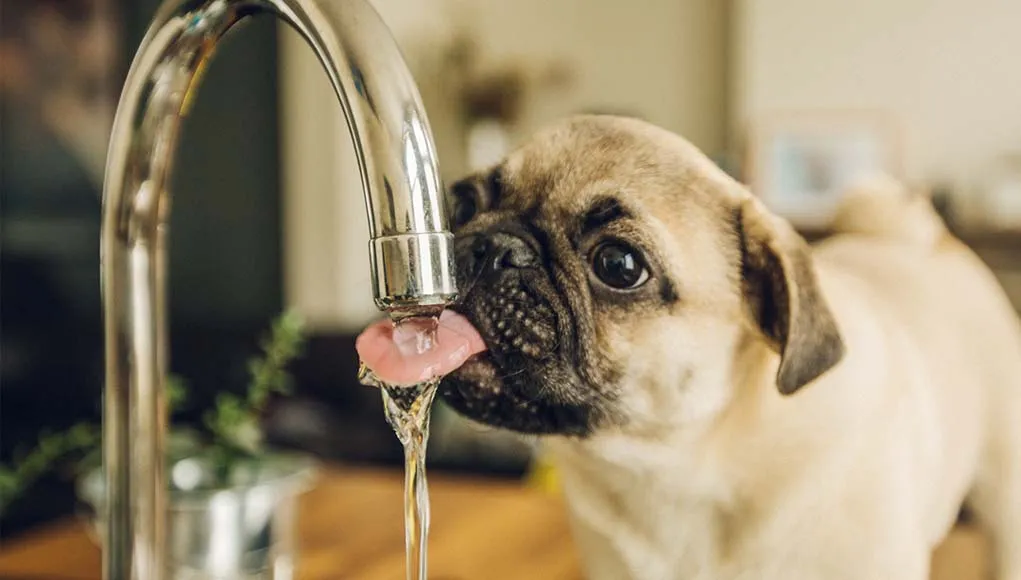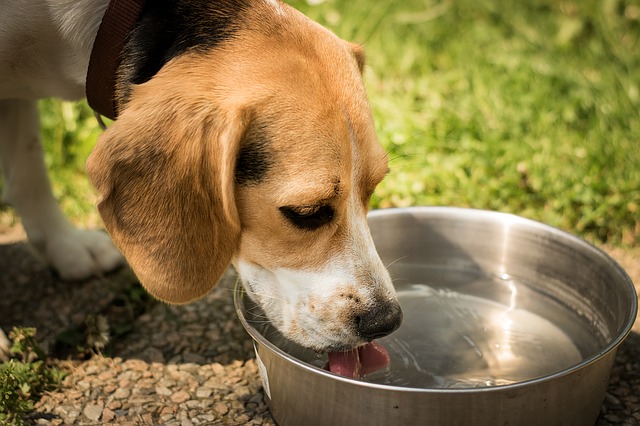Does your dog stop drinking? Do you notice that his water bowl does not empty during the day? You need to take this situation seriously.
By refusing to drink, your dog will become dehydrated and many health problems could arise.
If contacting a veterinarian remains the simplest and safest thing. There are also methods to make your 4-legged friend want to drink again.
Let’s look at how to get a dog that refuses to drink .
The importance for dogs to drink water regularly
Before seeing how to make a dog who refuses drink, it is essential to understand the risks that your dog incurs when he does not drink or not enough.
As with us humans, water plays a vital role in animals and for your dog. Indeed, water allows:
- Bring nutrients into your cells
- To facilitate digestion
- Effectively absorb all nutrients
- To regulate body temperature
- Optimize intellectual abilities
- …
As you will have understood, water is essential for the functioning of practically all parts of the body.
If you don’t drink enough, you’ll feel dizzy and tired. It’s the same for your dog .
If your dog stops hydrating and you don’t know how to get a refusing dog to drink, your beloved pet will suffer from dehydration.
If you don’t act quickly, his body will undergo major imbalances.
Water will gradually be lacking in the cells, which will cause muscle dysregulation and, ultimately, organ dysfunction.
Dehydration that is not treated quickly can lead to death .
This is why action should be taken immediately after noticing this problem in your dog. Here are the signs of dehydration that should alert you:
- Movements slower than usual
- A permanent state of fatigue
- A loss of appetite
- Dry mouth and nose
- An unusual gasp
The skin is also a very good indicator. By stroking your dog, you can tell if he has absorbed enough water or not.
If your 4-legged friend is dehydrated, his skin tends to lose its elasticity .
You can pinch your pet at the shoulder blades and see if the skin bounces back easily or not. The second case can be synonymous with dehydration.
What are the risks of a lack of water for your dog?

It is important to remember that if the problem of dehydration in a pet is not treated quickly, it can die.
Indeed, water regularly brings new nutrients to the cells thanks to the functioning of the kidneys.
When your 4-legged friend stops drinking water and you don’t know how to get a dog that refuses to drink, the kidneys have no choice but to recycle the water present in the blood.
This isn’t a short-term problem, but over a long period of time this will result in an increased concentration of toxins .
A dehydrated body will experience slowed blood circulation, thicker blood, lower organ supply.
Micro clots can form and block blood flow to the lungs and other vital organs.
Within days, dehydration can lead to the death of your pet.
What is the ideal amount of water your dog should consume each day?

Your dog does not drink as much as before or has completely stopped drinking? Do not panic, we are going to explain to you how to make a dog who refuses drink.
Sometimes it can happen that some people make too much water available to their pet and do not worry much about a risk of dehydration in their 4-legged friend.
You can use different techniques to measure the ideal amount of water for your pet.
But overall, it is estimated that a dog should drink between 50 and 70 ml of water per kg of body weight each day .
This estimate remains an average, your 4-legged friend may need a little more or a little less during his day.
Additionally, many factors can impact the amount of water your dog takes in.
The best thing to do is to always provide your pet with fresh water .
Do not limit his water intake on your own.
Is tap water safe for dogs to drink?
A brief digression to answer a question that many new dog owners ask themselves: can dogs drink tap water?
It all depends on the area you live in and whether the water is drinkable there or not.
As long as tap water is safe for us humans, it can be safely consumed by your pets.
If, on the other hand, tap water poses risks, look into bottled or filtered water options with your veterinarian to be on the safe side.
What are the possible reasons for your dog’s dehydration?
Before looking at how to make a dog that refuses drink, you must know the reasons that can explain the dehydration of your beloved animal.
Generally speaking, a dog can suffer from dehydration and all the problems that follow due to:
- From heat stroke
- Regular vomiting or diarrhea
- Insufficient water available to them
- From a chronic illness
1. Heatstroke
If your dog is exposed to the sun during periods of heat wave or high heat in summer, it is possible that the temperature of his body becomes deregulated and exceeds 41° Celsius .
Such an increase in body temperature can occur if you leave your dog in your car in direct sunlight or if your dog engages in strenuous physical activity for a long period of time.
Have you ever had the idea of leaving your pet in your car for a race? Many think that in 15-20 minutes, nothing will happen to their 4-legged friend. However, even if the outside temperature is around 15 degrees, your dog can get heat stroke in the space of about fifteen minutes. Don’t leave your dog in a closed car!
Even for a run that you think is quick, don’t make the mistake of leaving your dog inside a closed vehicle.
Make him wait quietly at your home or benefit from a car with very good air conditioning and a bowl to give him water during your short absence.
2. Continuous vomiting or diarrhea
As with humans, persistent vomiting and diarrhea cause regular fluid loss .
If your dog experiences this situation for more than 24 hours, take him immediately to the veterinary hospital for a diagnosis.
Indeed, your dog is not able to compensate for the loss of water caused by vomiting and diarrhea by drinking enough.
He will gradually become dehydrated, show symptoms of severe dehydration and risk serious health problems if he is not treated as soon as possible.
3. Not enough water available
If you are welcoming a dog into your home for the first time. You can be wrong about how much water to give your pet daily. Indeed, it happens that some owners do not make enough water available to their dog during the day;
To avoid this situation, keep a bowl of fresh water near your dog’s bowl.
If you have a garden, also put a bowl outside so that your 4-legged friend has water available at all times.
Don’t forget to wash the containers regularly so that the water is of good quality.
4. A chronic illness
Certain chronic diseases such as diabetes, kidney disease or even Cushing’s disease cause more rapid dehydration in pets.
Dogs with this type of disease tend to drink more regularly than average. But even with a higher than average consumption, they often remain dehydrated.
You must be particularly vigilant that your dog always has a bowl of fresh water within reach. You also need to be careful with their diet .
A good diet will provide extra fluids and can effectively combat dehydration in chronically ill dogs.
These are the main causes that explain dehydration in dogs. But before looking at how to make a dog that refuses drink, also know that there are specific causes of dehydration in puppies such as:
- Le parvovirus
- intestinal parasites
- An obstruction caused by a foreign body such as stones or toys
Does your dog stop drinking? Here’s what to do first
If you find that your dog’s water bowl isn’t draining as quickly as it used to or stays nearly full all day, the best thing by far is to schedule an appointment with a veterinarian .
As we explained to you before, you need to take this problem seriously and fix it as soon as possible. The people best qualified to help you are healthcare professionals.
Take your dog to a veterinary hospital as soon as you notice the first symptoms of dehydration.
Your dog will be taken care of and will perform a series of tests and physical exams to determine the cause .
All of these tests will help identify health issues that have caused your pet’s dehydration.
Heat stroke, intestinal worms, chronic illnesses… everything is carefully checked to be able to make the best possible diagnosis .
Once the cause has been established, the veterinarian will be able to put in place an effective treatment to restore your dog.
Most of the time, they will prescribe your 4-legged friend subcutaneous or intravenous fluids.
The objective of these treatments is to bring the missing water to the cells and organs of your dog’s body. By doing this, your pet will not suffer from electrolyte disturbances and will rehydrate over time.
How to help a dog that refuses to drink?
7 tips that work!
Several techniques can help keep your dog hydrated, before or after your vet appointment, if your dog refuses to drink. Here are the main ones:
1. Wash your water bowl
The first piece of advice is to wash your water bowl. Perhaps the container is dirty and your dog refuses to drink because of a bad smell.
Remember that dogs have a sense of smell 1 million times better than humans.
The slightest suspicious smell can therefore prevent them from drinking.
2. Change places to water
If your dog stops drinking, it’s also possible that his water bowl is in a place he doesn’t like.
For example, the water may be in a place of passage, a noisy place or a place with a lot of stimulation.
As with the food bowl, dogs need a quiet space in which they feel safe to refuel.
3. Add chicken broth
Another technique that works is adding chicken broth to the water. Be careful, however, to choose a chicken broth without salt .
4. Vary the water format
If your dog has trouble drinking classic mineral water, vary the formats.
For example, you can give him ice cubes , gelled water or even watermelon , which is rich in water.
5. Try wet food
If your dog refuses to drink, you can also try switching to wet food to increase his water intake. You can also moisten his kibble to hydrate him without him realizing it.
6. Avoid tap water
If your dog stops drinking or refuses to drink, the problem may be right at the source.
If you give him tap water, maybe he smells of chlorine or chemicals. Try switching to bottled or filtered water .
7. Use a pipette or syringe
Finally, if your dog is old or weakened, he may simply not have the strength to drink .
To help him hydrate and facilitate the ingestion of water, take a pipette or a syringe.
There are several ways to get a dog that refuses to drink .
These few tips should help you avoid the risk of dehydration.
Always have enough water available
This advice may seem simple, but it is essential. You should always keep in mind the amount of water in your dog’s bowl.
Replenish fresh water regularly and make sure the bowl is clean and check that your pet drinks often during the day.
For the ideal quantities, we have detailed them above.
But remember that this is only an average and the quantity changes according to the habits of your 4-legged friend.
Increase the amount of water if the weather is hot and humid or if your dog is exercising
If you’re in the middle of a heat wave or just the temperatures starting to rise above 20 degrees, pay attention to how much time your dog spends outside.
Try reducing it if the weather is humid or hot. As we said before, don’t make the mistake of leaving your dog inside your car when you go shopping either.
In these different situations, you need more water than usual to compensate for the high heat.
Keep vaccinations up to date and perform parasite prevention
By keeping vaccines up to date and regularly preventing intestinal worms and other parasites, you limit the risk of infectious diseases that can cause dehydration.
Pay attention to your dog’s diet
Diet also plays an important role in keeping your dog hydrated . avoid making him eat things that are bad for his health such as:
- fatty foods for humans
- Small items lying around your home
- Garbage
- Meal leftovers
Now you know how to get a dog that refuses to drink.
We have given you all the keys to prevent your dog from becoming dehydrated and especially to act quickly if you notice symptoms.
Apply our advice and enjoy a healthy pet !

